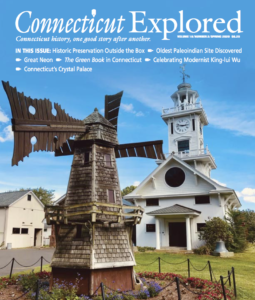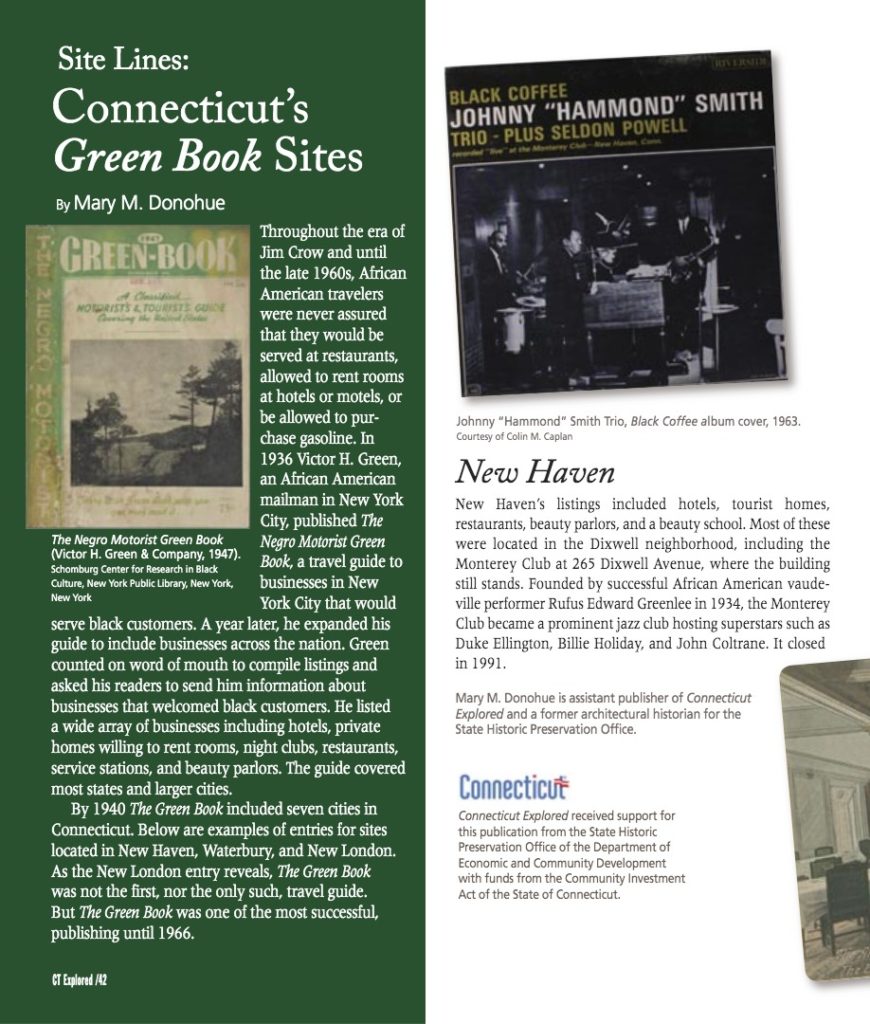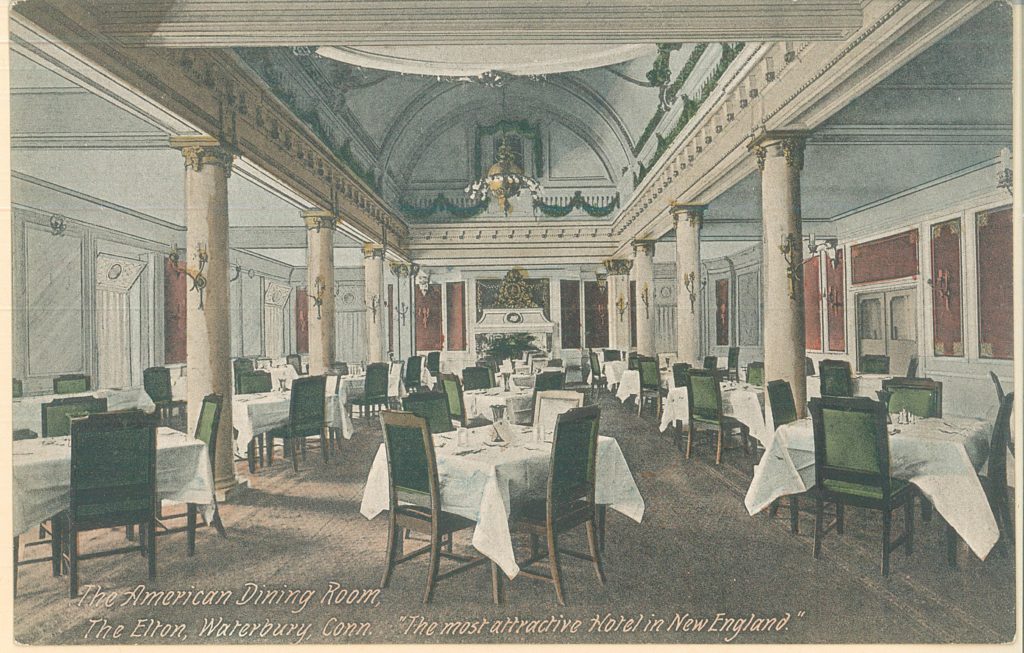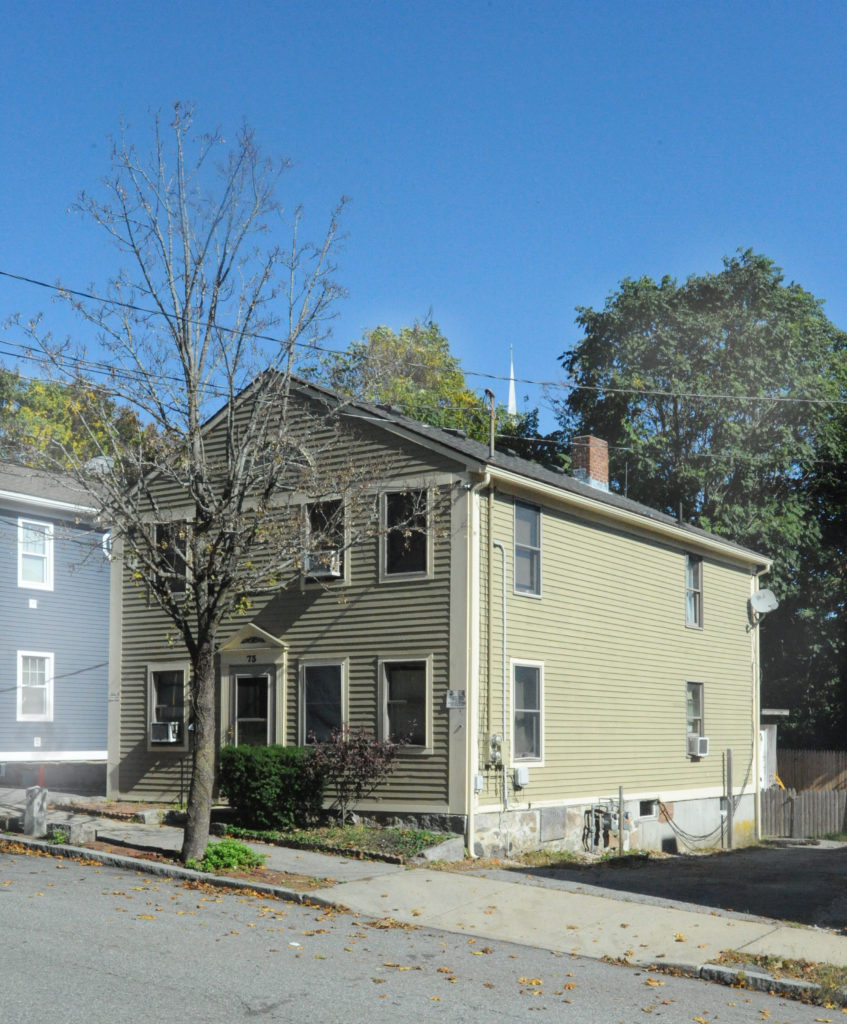(c) Connecticut Explored Inc. Spring 2020
Subscribe/Buy the Issue!
Throughout the era of Jim Crow and until the late 1960s, African American travelers were never assured that they would be served at restaurants, allowed to rent rooms at hotels or motels, or be allowed to purchase gasoline. In 1936 Victor H. Green, an African American mailman in New York City, published The Negro Motorist Green Book, a travel guide to businesses in New York City that would serve black customers. A year later, he expanded his guide to include businesses across the nation. Green counted on word of mouth to compile listings and asked his readers to send him information about businesses that welcomed black customers. He listed a wide array of businesses including hotels, private homes willing to rent rooms, night clubs, restaurants, service stations, and beauty parlors. The guide covered most states and larger cities.
By 1940 The Green Book included seven cities in Connecticut. Below are examples of entries for sites located in New Haven, Waterbury, and New London. As the New London entry reveals, The Green Book was not the first, nor the only such, travel guide. But The Green Book was one of the most successful, publishing until 1966.
New Haven
New Haven’s listings included hotels, tourist homes, restaurants, beauty parlors, and a beauty school. Most of these were located in the Dixwell neighborhood, including the Monterey Club at 265 Dixwell Avenue, where the building still stands. Founded by successful African American vaudeville performer Rufus Edward Greenlee in 1934, the Monterey Club became a prominent jazz club hosting superstars such as Duke Ellington, Billie Holiday, and John Coltrane. It closed in 1991.
Mary M. Donohue is assistant publisher of Connecticut Explored and a former architectural historian for the State Historic Preservation Office.
Waterbury
By Raechel Guest
A vibrant African American neighborhood established itself during the early 20th century in the ethnically diverse North Square area of Waterbury. During the late 1930s four apartment or tenement buildings on Pearl Street, all run by women, and the Community House were listed in The Green Book. The Pearl Street Neighborhood House, as the Community House came to be known, continued to be listed as offering lodgings for motorists into the 1960s. Still a community center, now owned by the Zion Baptist Church, it is a site on the Connecticut Freedom Trail.
One block over on Bishop Street, the Jones Hotel, opened in 1925 by African American entrepreneur Mack R. Jones, offered lodgings for motorists until about 1947. Waterbury’s premiere hotel, The Elton, built in 1904, opened its doors to African Americans in 1949. As reported in the Hartford-based African American newspaper The New England Bulletin(April 23, 1949), The Elton had until then refused African Americans not only lodging but also employment. Clyde Jennings, the hotel’s owner, changed his policy after deciding that “the race here, through its progress, had earned the right to work and live there,” The Bulletin reported. The Elton was listed on the National Register of Historic Places in 1983 and is currently a residential care facility.
Raechel Guest blogs about Waterbury at WaterburyThoughts.blogspot.com. She last wrote “The Brass City Manufactures for Victory,” Fall 2007.
New London
By Laura Natusch
The Hempstead Cottage at 73 Hempstead Street, listed in The Green Book from 1938 to 1950, was the home of Sarah (Sadie) Dillon Harrison. It is an important site both for its distinguished residents before and after Harrison lived there and as a place where African American travelers could stay overnight in New London in the early 20th century. Harrison listed her home in The Green Book’s precursor, Hackley and Harrison’s Hotel and Apartment Guide for Colored Travelers, published in Philadelphia in 1930 and 1931.
 In 1929 Harrison—then secretary of New London’s Negro Welfare Council—received a letter from the famed civil rights leader and NAACP founder W.E.B. Du Bois asking where in town he could stay overnight. As the Hackley and Harrison’s guide explains, “Mr. Du Bois was writing unknowingly to the originator of the Guide Idea. His query aptly illustrates the practicality and universal need of the public service hereby supplied.” Du Bois stayed at Harrison’s guest house on November 24, 1929.
In 1929 Harrison—then secretary of New London’s Negro Welfare Council—received a letter from the famed civil rights leader and NAACP founder W.E.B. Du Bois asking where in town he could stay overnight. As the Hackley and Harrison’s guide explains, “Mr. Du Bois was writing unknowingly to the originator of the Guide Idea. His query aptly illustrates the practicality and universal need of the public service hereby supplied.” Du Bois stayed at Harrison’s guest house on November 24, 1929.
In 1845 the house was one of five on Hempstead Street that white abolitionist Savillion Haley built and sold to black families. It was owned by acclaimed organist William Bush from 1919 to 1926. In the mid-1930s it was the childhood home of Linwood Bland Jr., who became president of the New London NAACP in the 1960s. Another former resident, Sara Chaney, is notable as the first black woman hired by a bank in New London in 1966 after Bland contacted the state civil rights commission on her behalf.
The Hempstead Cottage is part of the Hempstead Historic District listed on the Connecticut Freedom Trail.
Laura Natusch is executive director of New London Landmarks. She credits research by Mary Beth Baker, Tom Couser, and Tom Schuch in this story.
 Connecticut Explored received support for this publication from the State Historic Preservation Office of the Department of Economic and Community Development with funds from the Community Investment Act of the State of Connecticut.
Connecticut Explored received support for this publication from the State Historic Preservation Office of the Department of Economic and Community Development with funds from the Community Investment Act of the State of Connecticut.



